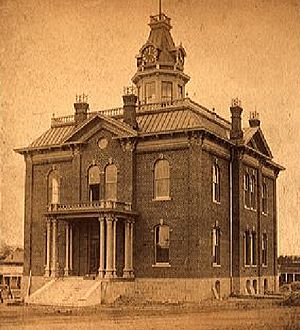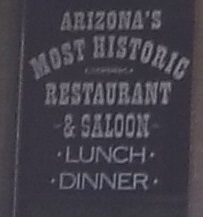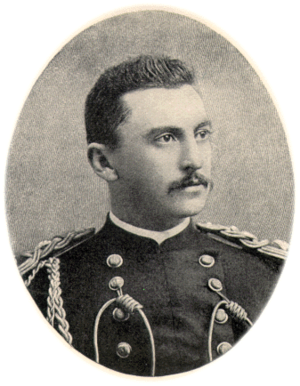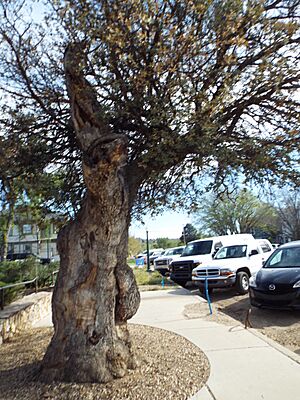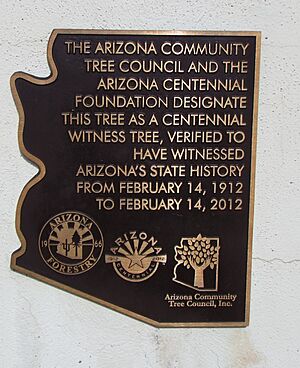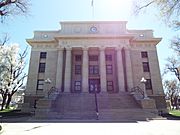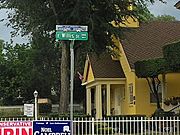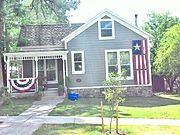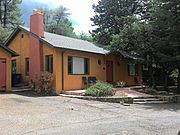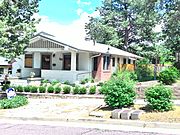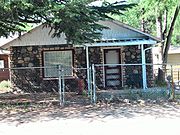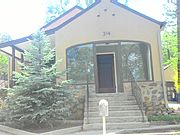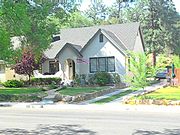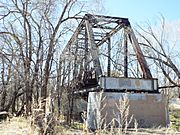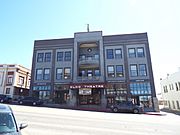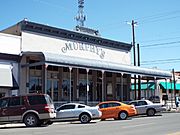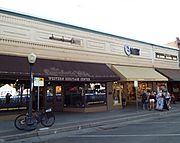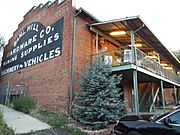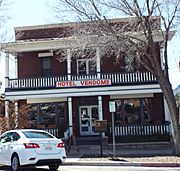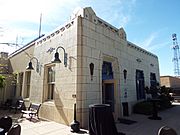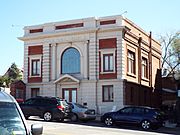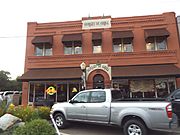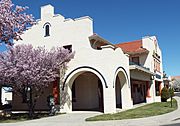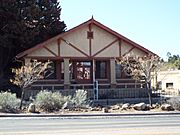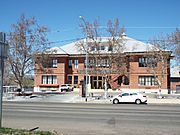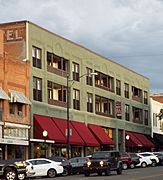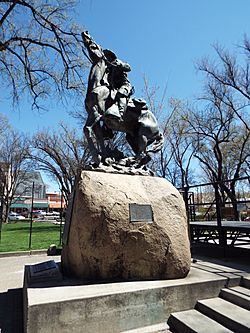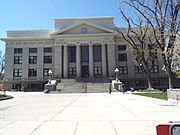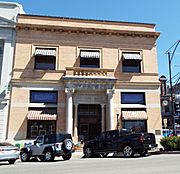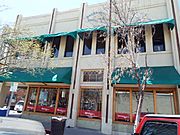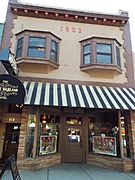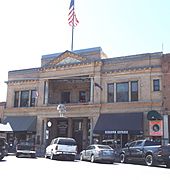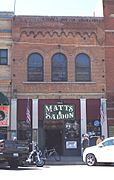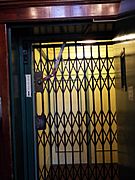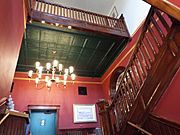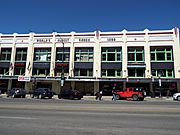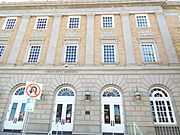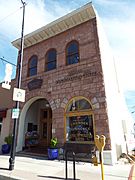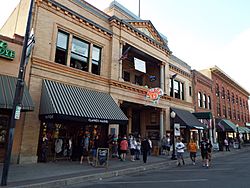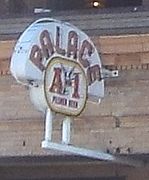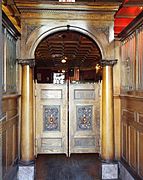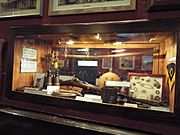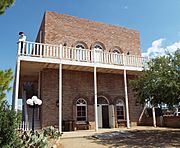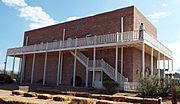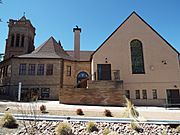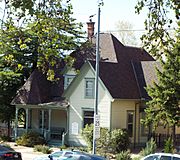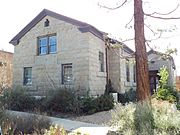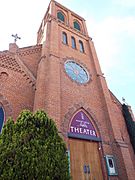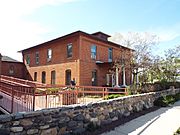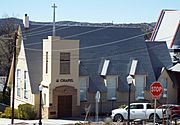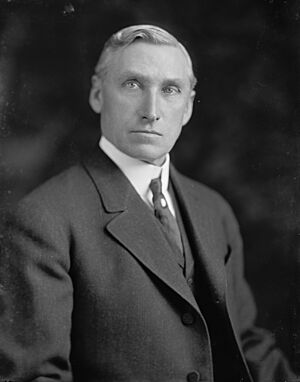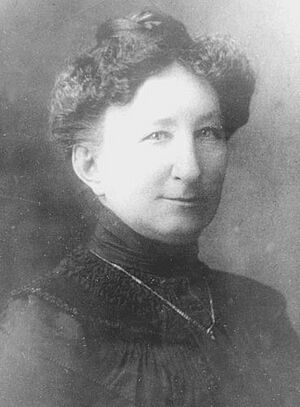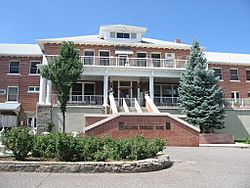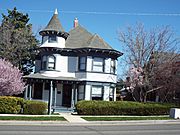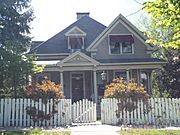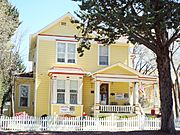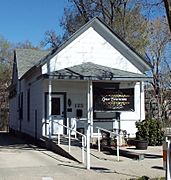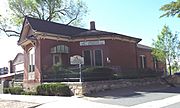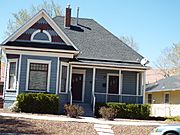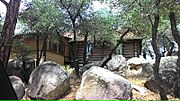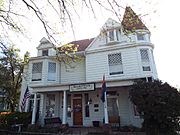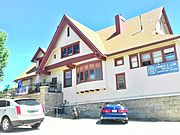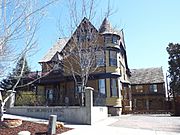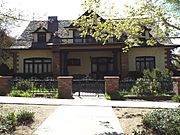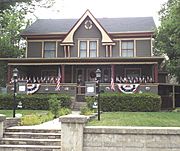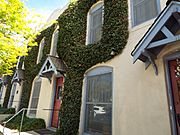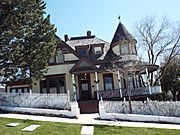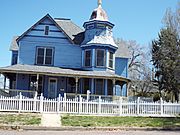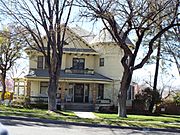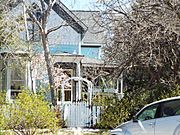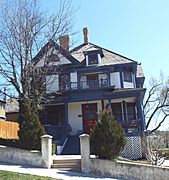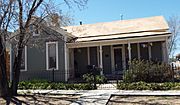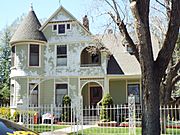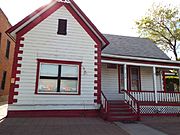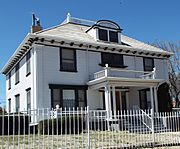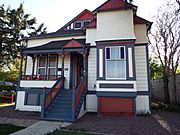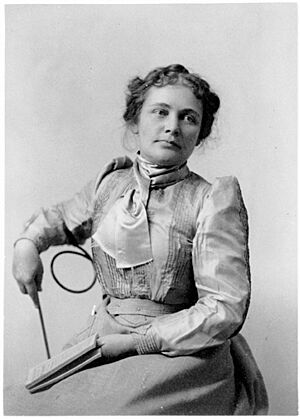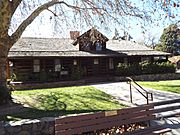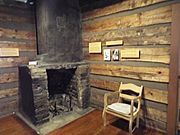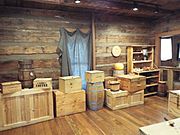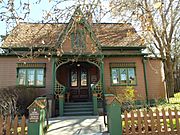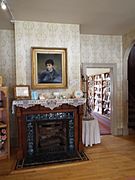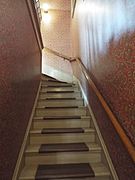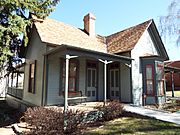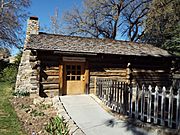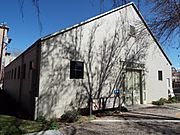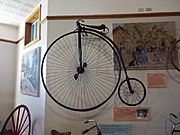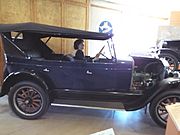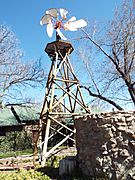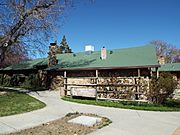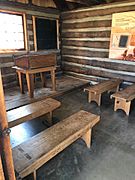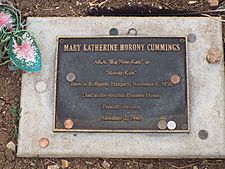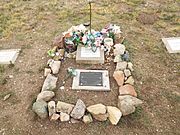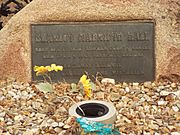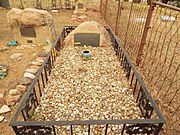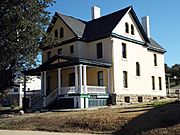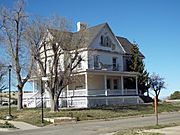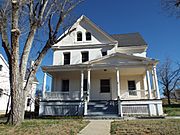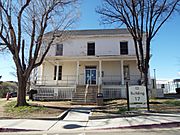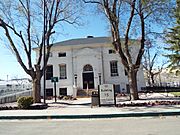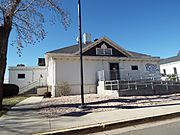List of historic properties in Prescott, Arizona facts for kids
Quick facts for kids
List of historic properties
in Prescott, Arizona |
|
|---|---|

Whiskey Row
|
|
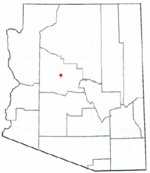
Location of Prescott in Yavapai County, Arizona.
|
This article explores the historic buildings and monuments in Prescott, Arizona. Prescott is the main city in Yavapai County. In 1864, it became the capital of the Arizona Territory, taking over from Fort Whipple. The capital moved to Tucson in 1867, then back to Prescott in 1877, and finally to Phoenix in 1889.
You'll see photos of buildings in special historic areas. These include the Downtown Historic Preservation District (which has "Whiskey Row"), the Courthouse Plaza Historic District, the Fort Whipple-Department of Veterans Affairs Medical Center Historic District, and the Sharlot Hall Museum.
Contents
Prescott's Early Days
The first people known to live in the Prescott area were the Yavapai tribe. Their name means "People of the Sun." They were hunter-gatherers, moving around to find food like plants and animals.
In the mid-1800s, more people of European descent started moving through Yavapai lands. This happened especially after gold was found in California in 1849. As settlers moved in, the Yavapai's hunting and farming lands became smaller. The Yavapai resisted, and many conflicts happened.
Prescott was officially started in 1864 as the capital of the Arizona Territory. Richard Cunningham McCormick, the territory's secretary, suggested naming it after historian William H. Prescott. John Noble Goodwin was appointed as the first Territorial Governor by President Abraham Lincoln. On June 7, 1864, the very first piece of land in Prescott was sold.
Fort Whipple was an important military base from 1864 to 1882. It was named after Lt. Amiel Whipple, who found gold nearby. The fort helped protect miners and settlers. After the American Civil War, the Yavapai people were moved to reservations when more gold was found on their land. For a short time, Fort Whipple was even the capital of the Arizona Territory.
Prescott officially became a town in 1883. It was also made the County Seat for Yavapai County. Prescott served as the Territorial Capital until 1889, except for ten years (1867–1877) when Tucson was the capital.
Richard Cunningham McCormick became Territorial Governor in 1866. Both he and Governor Goodwin lived in the Governor's Mansion, which you can now see at the Sharlot Hall Museum.
By 1878, Prescott had a famous street called "Whiskey Row." It was known for its many businesses and places for entertainment. A big fire, called "The Great Fire," destroyed much of Whiskey Row and five city blocks on July 14, 1900. After the fire, people rebuilt with stronger materials like concrete and brick. By 1901, the street was rebuilt. The Hotel Palace, D. Levy Mercantile Building, and St. Michael Hotel are some original buildings still standing today.
In 1888, William "Buckey" O'Neill was elected sheriff of Yavapai County. Later, he became Mayor of Prescott. In 1898, when war broke out between the United States and Spain, O'Neill joined the Rough Riders and became a Captain. He was sadly killed in action on July 1, 1898, during a battle.
By 1895, the Santa Fe, Prescott and Phoenix Railroad connected Prescott to other areas. This helped businesses grow, and new stores opened. Communication also improved with electric lights in 1889 and telephones soon after. Even though the capital moved to Phoenix in 1889, Prescott continued to grow. The copper mining industry also helped the area in the early 1900s, especially during World War I.
Protecting Prescott's History
Some buildings in Prescott are listed on the National Register of Historic Places. This list helps recognize important historical sites. However, being on the list doesn't always stop a building from being torn down. For example, the Goldwater Mercantile Building was listed in 1978 but was demolished later that year.
The Prescott Historical Society was started in 1964. It runs the Sharlot Hall Museum and the old Governor's Mansion. The society collects and shares historical items and information with the public.
The City of Prescott also has its own list of historic buildings. This list helps protect these special places. Buildings can be added to this list if they have:
- Historical or cultural importance.
- A unique architectural style or design.
- Visual appeal that adds to the beauty of the area.
There are also ancient ruins near Prescott from the Sinagua tribe. These ruins are listed on the National Register of Historic Places, but you can't visit them easily.
Historic Places to See
Historic Districts
Prescott has twelve areas recognized as historic districts by the National Register of Historic Places. These districts are groups of buildings that together tell a story about the past.
- Courthouse Plaza Historic District – Listed in 1978.
- East Prescott Historic District – Listed in 1989.
- Fleury's Addition Historic District – Listed in 1994.
- Hassayampa Historic District – Listed in 2003.
- Joslin and Whipple Historic District – Listed in 2000.
- Mile High Park Historic District – Listed in 1999.
- North Prescott Townsite Historic District – Listed in 2009.
- Pine Crest Historic District – Listed in 1989.
- Prescott Armory Historic District – Listed in 1994.
- South Prescott Townsite – Listed in 1998.
- West Prescott Historic District – Listed in 1989.
- Whipple Heights Historic District – Listed in 2000.
- Historic Districts
Historic Bridge
The Atchison, Topeka & Santa Fe Railway (ATSF) Granite Creek Bridge was built in 1910. It's a special type of railroad bridge. It was moved to the Downtown Prescott Greenways Trail, where you can see it today.
Important Buildings
Many individual buildings in Prescott are listed on the National Register of Historic Places. Here are some of them:
- Elks Building and Theater – Built in 1904.
- James I. Gardner Store – Built in 1890.
- Hassayampa Inn – Built in 1927.
- Sam Hill Hardware building – Built in 1900.
- Samuel Hill Hardware Company Warehouse – Built in 1903.
- Hotel Vendome – Built in 1917.
- Mountain States Telephone and Telegraph Exchange Building – Built in 1933.
- The City Park and Ball Field (also known as "Ken Lindley Field and Park") – Built in 1908.
- Carnegie library/Prescott Public Library – Built in 1903.
- Mulvenon Building – Built in 1901, one of the first after the 1900 fire.
- Prescott National Guard Armory – Listed in 1994.
- Santa Fe, Prescott and Phoenix Railroad Depot – Built in 1907.
- Sisters of Mercy Hospital and Convent – Built in 1896.
- United States Post Office and Courthouse – Built in 1931.
- The Washington Traditional School – Built in 1907.
- The A.J. Head Hotel – Built in 1901.
- The Santa Fe, Prescott and Phoenix Railway Depot – Built in 1894 (now the Iron Café).
Courthouse Plaza Historic District Buildings
In 1907, a statue of William "Buckey" O'Neill was placed in the historic Courthouse Plaza. Many buildings around the plaza are historically important:
- The Yavapai County Courthouse – Built in 1916.
- The Prescott Gas and Electric Company (1875)/ Masonic Temple (1907) – Built in 1875.
- The Bank of Arizona – Built in 1877.
- A.G. Dunn's Butcher Shop – Built in 1890.
- Bashford Burnister Building/Balentine Building – Built in 1901.
- The Grand Highland Hotel – Built in 1903.
- The Palace Hotel – Built in 1901.
- The D. Levy Mercantile Building – Built in 1901.
- Hotel St. Michael – Built in 1901. It used to be called the Burke Hotel before the 1900 fire.
- The Knights of Pythias Building – Built in 1892.
- The Prescott National Bank Building – Built in 1902.
- Bashford Courts – Built in 1888.
- The United States Post Office and Courthouse – Built in 1931.
- The Prescott Jail and Firehouse – Built in 1895. It was a fire station on the first floor and a jail on the second. Today, it's the Prescott Chamber of Commerce Tourist Information Center.
- The Olaf Helsa Clock – Built in 1920, located in front of the Helsa Jewelry Store.
The original Prescott Opera House was built in the early 1870s. It was later moved to the Pioneer Living History Museum in Phoenix. Famous performers like John Drew, Jr. and Lillie Langtry once performed there.
- The Prescott Opera House
Historic Churches
Prescott has several historic churches. Three of them are listed on the National Register of Historic Places.
- 1st Congressional Church and Parsonage – Built in 1899. It's the oldest Congregational Church in Arizona.
- Mormon Church – Built in 1927. It was later changed into a commercial building.
- Sacred Heart Catholic Church and Rectory – Built in 1894. Today, it's used as an art gallery.
- Solid Rock Christian Fellowship – Built in 1927.
- Houses of religious worship
Historic Homes
Many historic houses in Prescott are recognized for their importance.
- The Arizona Pioneers' Home – Built in 1911. It's a retirement home for early Arizona pioneers. Big Nose Kate, a famous figure from the Old West, is buried in its cemetery.
- The A. W. Robinson Building – Built in 1899.
- The Blumberg House – Built in 1900.
- The Brinkmeyer House – Built in 1899.
- The Burmister/Timerhoff House – Built in 1899. It belonged to Robert B. Burmister, whose mother was the daughter of a Territorial Governor. Later, a local politician and drug store owner, H. Timerhoff, lived there.
- The Clark House – Built in 1883. Eli Payson Clark was involved in railroads and served as Territorial Auditor.
- The Curtis Cottage – Built in 1881.
- The Day House – Built in 1887.
- The Detwiler House – Built in 1900.
- The Drake House – Built in 1901.
- The Charles H. Dunning Log Cabin – Built in 1932.
- The Fisher/Goldwater House – Built in 1894. Mayor Morris Goldwater lived here and later married Mrs. Fisher.
- The Fredericks House – R.N. Fredericks was a bank president and investor.
- The Gage/Murphy House – Built in 1875.
- The Goldwater-Henry House – Built in 1894. Henry was the uncle of U.S. Senator Barry Goldwater.
- The Lawler-Hetherington Double House – Built in 1894.
- The Hawkins House – Built in 1895. John J. Hawkins was a well-known attorney and judge.
- The Hazeltine House – Built in 1903. Moses Hazeltine Sherman helped organize Arizona's schools and later went into business.
- The Head House – Built in 1875.
- The Hill House – Built in 1906. It belonged to Amy Hill, widow of Sam Hill, who owned a large mercantile company.
- The Kenwill Apartments – Built in 1925.
- The Marks House – Built in 1875.
- The Martin/Ling House – Built in 1892.
- The Morin House – Built in 1899.
- The Morrison House – Built in 1902.
- The Otis House – Built in 1877. Theodore Weld Otis was a teacher, veteran, and grocer who served as a judge and postmaster.
- The Peters House – Built in 1898.
- The Roberts House – Built in 1880.
- The Sewall House – Built in 1893.
- The Shekels House – Built in 1872.
- The Sloan House – Built in 1900. This house belonged to Richard Elihu Sloan, who was the last territorial governor.
- The Wells House – Built in 1878.
- The Wilder House – Built in 1891.
Sharlot Hall Museum
The Sharlot Hall Museum is named after Sharlot Hall, who became Arizona's first woman to hold public office in 1909 as the territorial historian. Two of the museum's exhibits are listed on the National Register of Historic Places: the Governor's Mansion (1864) and the Iron Turbine Windmill (1876). Here are some of the outdoor exhibits you can see:
- The Old Governor's Mansion – Built in 1864. This was the home of Governor John Goodwin.
- The Bashford House – Built in 1877, a Victorian-style house.
- The Fremont House – Built in 1875. This was the home of Governor John Fremont.
- Fort Misery – A log cabin built in 1864, the oldest log building from the Arizona Territory.
- The Ranch House – Built in the 1930s, a simple one-room house.
- The Transportation Building – Built in 1937. It holds old vehicles like a stagecoach, a Conestoga wagon, and Sharlot Hall's own car.
- The Sharlot Hall Building – Built in 1936. It houses many of the museum's historical exhibits.
- The Iron Turbine Windmill – Built in 1876. It's a very rare example of an early all-metal windmill.
- A replica of Prescott's First Community Schoolhouse – The original was built in 1872.
Arizona Pioneer Home Cemetery
The Arizona Pioneers’ Home Cemetery was started in 1911 on the site of an older cemetery from 1864. It's located on a hill. Some notable people buried here include:
- Mary Katherine Horony-Cummings – (1849–1940), also known as Big Nose Kate. She was a companion to the famous Old West gunfighter Doc Holliday.
- Kate Thompson Cory – (1861–1958) was an American photographer and artist who lived with the Hopi people and took many pictures of their lives.
- Sharlot Mabridth Hall – (1870–1943) was the first woman to hold a public office in the Arizona Territory. Her personal collection helped start the history museum named after her.
-
Grave-site of Kate T. Cory
Fort Whipple's Historic Buildings
Fort Whipple is listed as a historic district. Many buildings from 1872 are still standing there.
- The Fort Whipple Museum, which used to be the Commanding Officer's Quarters.
- The Fort Whipple NCO Quarters (NCO stands for Non-Commissioned Officer).
- The Fort Whipple Army Barracks (where soldiers lived).
- The Fort Whipple Post Headquarters (the main office).
- The Fort Whipple Theater.
- The Fort Whipple Guardhouse.
See also




